Different Types of T-shirt Printing Methods for T-shirt Business, T-shirt Printing Methods Pros and Cons
A type of casual shirt that basically has short sleeves, as well as a round neckline, is known as a T-shirt. It’s generally manufactured of lightweight fabric and is currently considered a popular option for everyday wear. So, if anyone is interested in initiating the t-shirt business or looking for ways to well organize their operations, here the question comes “What kind of t-shirt printing method works great for the business?”. So, to get into this there are different many ways available to get your t-shirt designs printed, starting from direct-to-garment printing, silk screening, and many more. In this article, we present Different Types of T-Shirt Printing Methods and their Pros and Cons.
Every method has its own advantages and disadvantages, so t-shirt printing methods have pros and cons that come into the picture when considering how to get your t-shirts into production. Important factors in your decision basically involve the appearance of your design, and the fabric of the t-shirt, the important one is the quantity of your print run, and your budget. In this article, we’ll study some of the most popular types of shirt prints to help you identify which t-shirt printing method is best for your T-shirt business.
Different types of T-shirt Printing Methods
- Direct-to-Garment Printing (DTG)
- Screen or silkscreen printing
- Dye sublimation printing
- Heat transfer vinyl printing (HTV printing)
- Direct-to-Film Printing (DTF)
- Belt Printing
1. Direct-to-Garment Printing (DTG)
This printing method particularly uses an inkjet printer to print the artwork on the garment. The specialty of this method is that it provides a full-color, good-quality print, making it perfect for complicated designs or photographic images. Here, one important aspect is inkjet printers are costlier but other than that, they do not possess any setup costs due to this it is more cost-effective for smaller orders. For the one who requires only a few T-shirts, this printing method is your best option. This process requires a pre-treatment step because the inks are directly printed on the fabric of the t-shirt, and pre-treatment allows the ink to be properly fixed and won’t let it soak through the material.
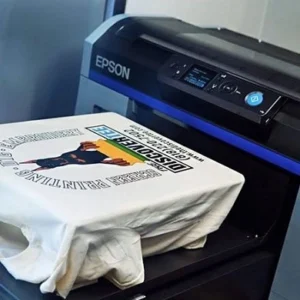
Pros:
- It is perfect when we have detailed multi-color designs
- It gives a high-production
- Here, inks directly penetrate the fabric, so you won’t able to feel the print when you touch it
Cons:
- It is the best-suited method for 100% cotton t-shirts or kind of blends
- It is found that DTG printing machines are costly
2. Screen or Silkscreen Printing
This method of printing is a stencil-based technique, in this method, the ink is applied to the t-shirt with the help of a mesh screen. It’s found to be the most famous printing method and has been available for more than a decade, initially, it was done by hand and now it is started by printing machines. This method particularly uses different and special screen printing inks which are thicker in nature than those used for regular printing methods, which majorly results in very vibrant, longer-lasting prints. This method was highly suitable for large orders of up to 500 t-shirts because it is found to be relatively quick and easy to set up.
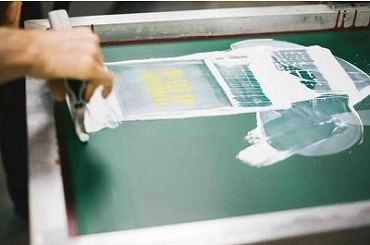
Pros:
- a. In this method ink is intensely absorbed into fibers, which makes stunning vibrant prints.
- b. It is a relatively fast printing process for more quantity of t-shirts.
- c. The feature is that it can be used on most materials such as cotton, polyester, and various blends.
Cons:
- a. This method is not suitable Limited for covering the whole t-shirt.
- b. It has limited colors, which means that it is not possible to achieve an extremely colorful design or go for printing a super vivid photograph the your t-shirt.
3. Dye sublimation Printing: T-shirt Printing Method
This method is also called all-over printing, the reason behind that is that it can be applied to all areas of a shirt. For instance, with the help of dye sublimation, it is possible to print the repeated patterns or cover areas such as seams. As compared to DTG and screen printing techniques it is different, which apply ink to particular printing areas on flat shirt surfaces. This method consists of a three-step process:
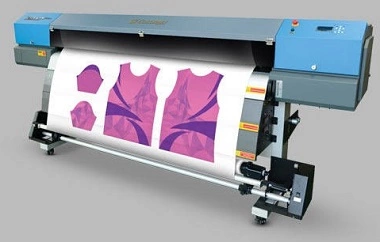
- To create a digital image file of a t-shirt design.
- Then a special kind of printer prints the image in reverse direction on transfer paper.
- Then the paper is to be pressed to the t-shirt, which is heated under pressure to a gaseous state, after that it is to be cooled down, by transferring the ink to the shirt.
Pros:
- With this method, print can be printed all over a t-shirt.
- When it comes to sublimated inks, it can blend right into the fabric of the shirt, which creates a smooth look and feel.
- It is seen that sublimated t-shirt designs won’t fade or peel easily.
Cons:
- a. This method doesn’t suit well, particularly with cotton or dark T-shirts.
- b. It is an expensive method when compared with other t-shirt printing options.
4. Heat transfer vinyl printing (HTV printing)
This method is also called iron-on printing, which specifically transfers designs from vinyl plastic-based sheets. Here, one side of the sheet is colored with removable tape which is then cut into design shapes. The other side of the sheet is coated with an adhesive which is being activated by heating. It consists of a five-step process:
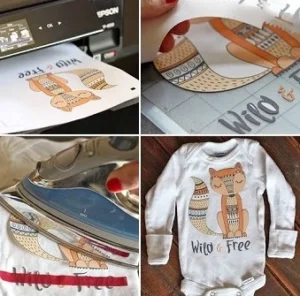
- The pattern which is to be cut is created either manually or digitally.
- The design can be cut out by hand or one can also go with an HTV cutting machine.
- Extra material is being removed by cutting.
- The design is then particularly applied to the t-shirt with the help of an iron or heat press.
- Then at last the tape is peeled away so that it will leave the image behind.
Pros:
- It is a comparatively easy method for beginners.
- Found to be relatively inexpensive.
Cons:
- Here, design cutting takes more time, which makes the production process slow.
- Vinyl particularly creates stiff and rigid designs.
- It doesn’t work properly on dark backgrounds.
- This process is limited to fabrics that can sustain the heating process.
5. Direct-to-Film Printing (DTF) T-shirt Printing Method
It is found to be the most common type of shirt printing method and is considered one of the best t-shirt printing methods and includes printing designs onto a special PET film (Polyethylene Terephthalate) and then it is transferred to a t-shirt using adhesive powder and heat. It is the opposite of DTG printing, as it doesn’t require pre-treatment of the garment because the design is already printed onto a film. The special feature of this method is that it can be used on any type of fabric. Simply develop polyester t-shirts or cotton t-shirts, and the result is found to be equally good. In the DTG method the design and inks are merged into the fabric, whereas with the help of the DTF method, the fixing powder makes the design plasticky and shiny.
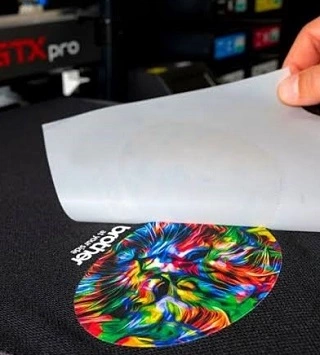
Pros:
- a. This method gives printing on a variety range of fabrics.
- b. It gives very bright and beautiful prints because the designs are applied on the fabric without penetrating the fibers
- c. It can be transferred into any base color
Cons:
- a. It can be used only on smaller items such as t-shirts, cushion covers, or face masks
- b. The feeling of the print is rather plasticky
- c. The entire process is found to be more complicated than dye sublimation or DTG printing
6. Belt Printing
In this method, a belt printer transports t-shirts to stations in a straight line with the help of a large belt. It is found that many people refer to this as “Belt Printing” since in the past, screen prints have been generated particularly using what is known as “a belt printer.” Belt printers are generally gigantic printers that imprint clothes on colossal screens. The function of belt printers has been supposed by large table printers.
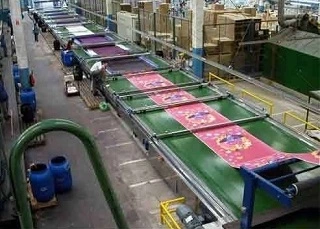
When it comes to creativity, there are no limitations to this method. This method with unique patterns covering full types of clothing prints will let your personality shine through. This method basically demands artwork that extends the seams and, on rare occasions, also features parts like sleeves, hem, collar, or all of them.
Pros:
- a. It is lighter
- b. This process is found to be cheaper
- c. Here, there is easily movable ground
Cons:
- a. With this method there is consistency of design, but the speed is low
- b. It is printed with different colors registration
Conclusion
So, summaries with, it is easy to transform a basic t-shirt into a design that expresses your personality and persona. One can easily change the printing process to meet the particular demands for both personal as well as professional use. There are many types of printing methods such as screen printing, direct-to-garment printing, dye-sublimation, heat press printing, and heat transferable vinyl which are popular ones, which is explained above. Nowadays, it is seen that there are many kinds of printing on shirts with images, though these are the types that particularly predominate in the industry. When it comes to small-scale printing applications, it benefits from methods that include vinyl cutouts, heat transfers, as well as stenciling. One must go for the different type of shirt printing method that best suits their business.
4. References
- https://printify.com/blog/types-of-shirt-printing/
- https://www.gelato.com/blog/types-of-shirt-prints
- https://silverbobbin.com/types-of-printing-on-t-shirts/
- https://artrageousapparel.com/blogs/blog/what-are-the-different-types-of-t-shirt-printing-options
- https://affixapparel.com/blog/types-of-shirt-printing/
- You may love to read: Types of Screen Printing, and Its Use
- Block Printing in Textile Industry: Types, Methods, and Advantages
- Common Printing Defects in Fabric | Causes and Remedies
- Digital Printing on Fabric: Digital Printing Process Step By Step
